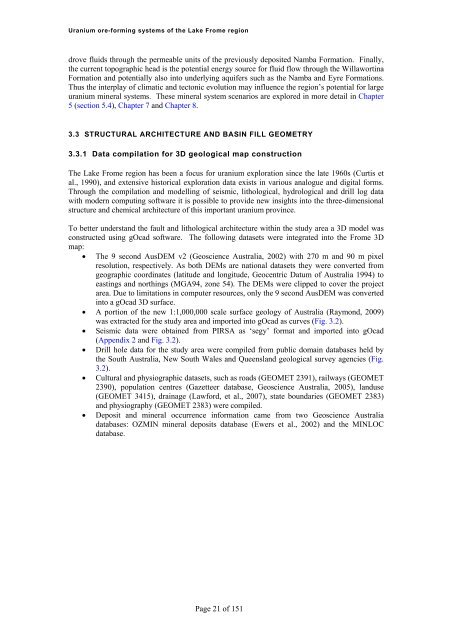Uranium ore-forming systems of the - Geoscience Australia
Uranium ore-forming systems of the - Geoscience Australia
Uranium ore-forming systems of the - Geoscience Australia
You also want an ePaper? Increase the reach of your titles
YUMPU automatically turns print PDFs into web optimized ePapers that Google loves.
<strong>Uranium</strong> <strong>ore</strong>-<strong>forming</strong> <strong>systems</strong> <strong>of</strong> <strong>the</strong> Lake Frome regiondrove fluids through <strong>the</strong> permeable units <strong>of</strong> <strong>the</strong> previously deposited Namba Formation. Finally,<strong>the</strong> current topographic head is <strong>the</strong> potential energy source for fluid flow through <strong>the</strong> WillawortinaFormation and potentially also into underlying aquifers such as <strong>the</strong> Namba and Eyre Formations.Thus <strong>the</strong> interplay <strong>of</strong> climatic and tectonic evolution may influence <strong>the</strong> region’s potential for largeuranium mineral <strong>systems</strong>. These mineral system scenarios are expl<strong>ore</strong>d in m<strong>ore</strong> detail in Chapter5 (section 5.4), Chapter 7 and Chapter 8.3.3 STRUCTURAL ARCHITECTURE AND BASIN FILL GEOMETRY3.3.1 Data compilation for 3D geological map constructionThe Lake Frome region has been a focus for uranium exploration since <strong>the</strong> late 1960s (Curtis etal., 1990), and extensive historical exploration data exists in various analogue and digital forms.Through <strong>the</strong> compilation and modelling <strong>of</strong> seismic, lithological, hydrological and drill log datawith modern computing s<strong>of</strong>tware it is possible to provide new insights into <strong>the</strong> three-dimensionalstructure and chemical architecture <strong>of</strong> this important uranium province.To better understand <strong>the</strong> fault and lithological architecture within <strong>the</strong> study area a 3D model wasconstructed using gOcad s<strong>of</strong>tware. The following datasets were integrated into <strong>the</strong> Frome 3Dmap:The 9 second AusDEM v2 (<strong>Geoscience</strong> <strong>Australia</strong>, 2002) with 270 m and 90 m pixelresolution, respectively. As both DEMs are national datasets <strong>the</strong>y were converted fromgeographic coordinates (latitude and longitude, Geocentric Datum <strong>of</strong> <strong>Australia</strong> 1994) toeastings and northings (MGA94, zone 54). The DEMs were clipped to cover <strong>the</strong> projectarea. Due to limitations in computer resources, only <strong>the</strong> 9 second AusDEM was convertedinto a gOcad 3D surface. A portion <strong>of</strong> <strong>the</strong> new 1:1,000,000 scale surface geology <strong>of</strong> <strong>Australia</strong> (Raymond, 2009)was extracted for <strong>the</strong> study area and imported into gOcad as curves (Fig. 3.2).Seismic data were obtained from PIRSA as ‘segy’ format and imported into gOcad(Appendix 2 and Fig. 3.2).Drill hole data for <strong>the</strong> study area were compiled from public domain databases held by<strong>the</strong> South <strong>Australia</strong>, New South Wales and Queensland geological survey agencies (Fig.3.2).Cultural and physiographic datasets, such as roads (GEOMET 2391), railways (GEOMET2390), population centres (Gazetteer database, <strong>Geoscience</strong> <strong>Australia</strong>, 2005), landuse(GEOMET 3415), drainage (Lawford, et al., 2007), state boundaries (GEOMET 2383)and physiography (GEOMET 2383) were compiled.Deposit and mineral occurrence information came from two <strong>Geoscience</strong> <strong>Australia</strong>databases: OZMIN mineral deposits database (Ewers et al., 2002) and <strong>the</strong> MINLOCdatabase.Page 21 <strong>of</strong> 151
















